
Horse gait
Encyclopedia
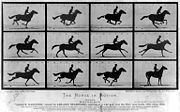
Horse
The horse is one of two extant subspecies of Equus ferus, or the wild horse. It is a single-hooved mammal belonging to the taxonomic family Equidae. The horse has evolved over the past 45 to 55 million years from a small multi-toed creature into the large, single-toed animal of today...
can move, either naturally or as a result of specialized training
Horse training
Horse training refers to a variety of practices that teach horses to perform certain behaviors when asked to do so by humans. Horses are trained to be manageable by humans for everyday care as well as for equestrian activities from horse racing to therapeutic horseback riding for people with...
by humans.
Classification
Gaits can be roughly categorized into two groups: the "natural" gaits that nearly every horse will use without special training, and the "amble," or the "amblingAmbling
The term amble or ambling is used to describe a number of four-beat intermediate gaits of horses. All are faster than a walk but usually slower than a canter or gallop...
" gaits, a collection of several other smooth footfall patterns that may appear naturally in some individuals but which usually occur only in certain breeds, and often require special training of the horse before a rider
Equestrianism
Equestrianism more often known as riding, horseback riding or horse riding refers to the skill of riding, driving, or vaulting with horses...
can request them on command.
Another classification system, applicable to quadruped
Quadruped
Quadrupedalism is a form of land animal locomotion using four limbs or legs. An animal or machine that usually moves in a quadrupedal manner is known as a quadruped, meaning "four feet"...
s in general, uses the categories of 1) walking gaits (including ambling), 2) running or trotting gaits, and 3) leaping gaits.
The British Horse Society Dressage Rules require competitors to perform 4 variations of the walk, 6 forms of the trot, 5 leaping gaits (all forms of the canter), halt, and rein back but not the gallop. The British Horse Society Equitation examinations also require proficiency in the gallop as distinct from the canter.
The so-called "natural" gaits, in increasing order of speed, are the walk, trot, canter, and gallop. Some people count these as three gaits by considering the canter a variation of the gallop, even though the canter is distinguished by having three beats, whereas the gallop has four beats. All four gaits are seen in wild horse populations. While other intermediate speed gaits may occur naturally to some horses, these four basic gaits occur in nature across almost all horse breeds. In some animals, the trot is completely replaced by the pace or by an ambling
Ambling
The term amble or ambling is used to describe a number of four-beat intermediate gaits of horses. All are faster than a walk but usually slower than a canter or gallop...
gait. More often, horses who possess an ambling gait are also able to trot.
Walk
The walk is a four-beat gait that averages about 4 miles per hour (6.4 km/h). When walking, a horse's legs follow this sequence: left hind leg, left front leg, right hind leg, right front leg, in a regular 1-2-3-4 beat. At the walk, the horse will always have one foot raised and the other three feet on the ground, save for a brief moment when weight is being transferred from one foot to another. A horse moves its head and neck in a slight up and down motion that helps maintain balance.Ideally, the advancing rear hoof oversteps the spot where the previously advancing front hoof touched the ground. The more the rear hoof oversteps, the smoother and more comfortable the walk becomes. Individual horses and different breeds vary in the smoothness of their walk. However, a rider will almost always feel some degree of gentle side-to-side motion in the horse's hips as each hind leg reaches forward.
The fastest walk is the hereditary "running walk" of the Tennessee Walking Horse, described under "Ambling gaits" below. If a horse begins to speed up and lose a regular cadence to its gait, the horse is no longer walking, but is beginning to either trot or move into an alternative ambling or "singlefoot" gait.
Trot
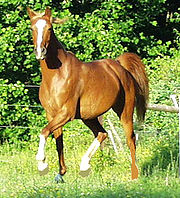
Harness racing
Harness racing is a form of horse racing in which the horses race at a specific gait . They usually pull a two-wheeled cart called a sulky, although racing under saddle is also conducted in Europe.-Breeds:...
, the trot of a Standardbred is faster than the gallop of the average non-racehorse
Horse racing
Horse racing is an equestrian sport that has a long history. Archaeological records indicate that horse racing occurred in ancient Babylon, Syria, and Egypt. Both chariot and mounted horse racing were events in the ancient Greek Olympics by 648 BC...
.
In this gait, the horse moves its legs in unison in diagonal pairs. From the standpoint of the balance of the horse, this is a very stable gait, and the horse need not make major balancing motions with its head and neck.
The trot is the working gait for a horse. Despite what one sees in movies, horses can only canter and gallop for short periods at a time, after which they need time to rest and recover. Horses in good condition can maintain a working trot for hours. The trot is the main way horses travel quickly from one place to the next.
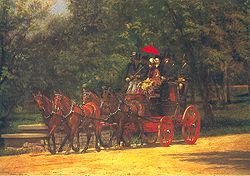
English riding
English riding is a term used to describe a form of horse riding that is seen throughout the world. There are many variations in English riding, but all feature a flat English saddle without the deep seat, high cantle or saddle horn seen on a Western saddle nor the knee pads seen on an Australian...
disciplines, most riders post to the trot, rising up and down in rhythm with the horse to avoid being jolted. Posting is easy on the horse's back, and once mastered is also easy on the rider.
To not be jostled out of the saddle and to not harm the horse by bouncing on its back, riders must learn specific skills in order to sit the trot. Most riders can easily learn to sit a slow jog trot without bouncing. A skilled rider can ride even a powerfully extended trot without bouncing, but to do so requires well-conditioned back and abdominal muscles, and to do so for long periods is tiring for even experienced riders. A fast, uncollected, racing trot, such as that of the harness racing horse, is virtually impossible to sit.
Because the trot is such a safe and efficient gait for a horse, learning to ride the trot correctly is an important component in almost all equestrian
Equestrianism
Equestrianism more often known as riding, horseback riding or horse riding refers to the skill of riding, driving, or vaulting with horses...
disciplines. Nonetheless, "gaited" or "ambling" horses that possess smooth 4-beat intermediate gaits that replace or supplement the trot (see "ambling gaits" below), are popular with riders who prefer for various reasons not to have to ride at a trot.
Two variations of the trot are specially trained in advanced dressage
Dressage
Dressage is a competitive equestrian sport, defined by the International Equestrian Federation as "the highest expression of horse training." Competitions are held at all levels from amateur to the World Equestrian Games...
horses: the Piaffe
Piaffe
The piaffe[p] is a dressage movement where the horse is in a highly collected and cadenced trot, in place or nearly in place. The center of gravity of the horse should be more towards the hind end, with the hindquarters slightly lowered and great bending of the joints in the hind legs...
and the Passage
Passage (dressage)
The passage is a movement seen in upper-level dressage, in which the horse performs a highly elevated and extremely powerful trot. The horse is very collected and moves with great impulsion....
. The Piaffe is essentially created by asking the horse to trot in place, with very little forward motion. The Passage (rhymes with "massage") is an exaggerated slow motion trot. Both require tremendous collection, careful training and considerable physical conditioning for a horse to perform.
Canter and gallop
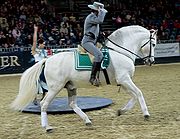
Canter
The canter is a controlled, three-beat gait that usually is a bit faster than the average trot, but slower than the gallop. The average speed of a canter is between 16–27 km/h (10–17 mph), depending on the length of the stride of the horse. Listening to a horse canter, one can usually hear the three beats as though a drum had been struck three times in succession. Then there is a rest, and immediately afterwards the three-beat occurs again. The faster the horse is moving, the longer the suspension time between the three beats. The word is thought to be short for "CanterburyCanterbury
Canterbury is a historic English cathedral city, which lies at the heart of the City of Canterbury, a district of Kent in South East England. It lies on the River Stour....
gallop."
In the canter, one of the horse's rear legs – the right rear leg, for example – propels the horse forward. During this beat, the horse is supported only on that single leg while the remaining three legs are moving forward. On the next beat the horse catches itself on the left rear and right front legs while the other hind leg is still momentarily on the ground. On the third beat, the horse catches itself on the left front leg while the diagonal pair is momentarily still in contact with the ground.
The more extended foreleg is matched by a slightly more extended hind leg on the same side. This is referred to as a "lead". Except in special cases, such as the counter-canter, it is desirable for a horse to lead with its inside legs when on a circle. Therefore, a horse that begins cantering with the right rear leg as described above will have the left front and hind legs each land farther forward. This would be referred to as being on the "left lead".
When a rider is added to the horse's natural balance, the question of the lead becomes more important. When riding in an enclosed area such as an arena, the correct lead provides the horse with better balance. The rider typically signals the horse which lead to take when moving from a slower gait into the canter. In addition, when jumping over fences, the rider typically signals the horse to land on the correct lead to approach the next fence or turn. The rider can also request the horse to deliberately take up the wrong lead (counter-canter), a move required in some dressage
Dressage
Dressage is a competitive equestrian sport, defined by the International Equestrian Federation as "the highest expression of horse training." Competitions are held at all levels from amateur to the World Equestrian Games...
competitions and routine in polo
Polo
Polo is a team sport played on horseback in which the objective is to score goals against an opposing team. Sometimes called, "The Sport of Kings", it was highly popularized by the British. Players score by driving a small white plastic or wooden ball into the opposing team's goal using a...
, which requires a degree of collection and balance in the horse. The switch from one lead to another without breaking gait is called the "flying lead change" or "flying change". This switch is also a feature of dressage and reining
Reining
Reining is a western riding competition for horses where the riders guide the horses through a precise pattern of circles, spins, and stops. All work is done at the lope and gallop; the fastest of the horse gaits...
schooling and competition.
If a horse is leading with one front foot but the opposite hind foot, it produces an awkward rolling movement, called a cross-canter, disunited canter or "cross-firing."
The lope is a Western term for the canter.
Gallop
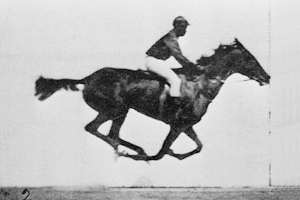

Predation
In ecology, predation describes a biological interaction where a predator feeds on its prey . Predators may or may not kill their prey prior to feeding on them, but the act of predation always results in the death of its prey and the eventual absorption of the prey's tissue through consumption...
or simply cover short distances quickly. Horses seldom will gallop more than 1 or before they need to rest, though horses can sustain a moderately-paced gallop for longer distances before they become winded and have to slow down.
The gallop is also the gait of the classic race horse
Horse racing
Horse racing is an equestrian sport that has a long history. Archaeological records indicate that horse racing occurred in ancient Babylon, Syria, and Egypt. Both chariot and mounted horse racing were events in the ancient Greek Olympics by 648 BC...
. Modern Thoroughbred
Thoroughbred
The Thoroughbred is a horse breed best known for its use in horse racing. Although the word thoroughbred is sometimes used to refer to any breed of purebred horse, it technically refers only to the Thoroughbred breed...
horse races are seldom longer than 1.5 miles (2.4 km), though in some countries Arabian horse
Arabian horse
The Arabian or Arab horse is a breed of horse that originated on the Arabian Peninsula. With a distinctive head shape and high tail carriage, the Arabian is one of the most easily recognizable horse breeds in the world. It is also one of the oldest breeds, with archaeological evidence of horses...
s are sometimes raced as far as 2.5 miles (4 km). The fastest galloping speed is achieved by the American quarter horse
American Quarter Horse
The American Quarter Horse is an American breed of horse that excels at sprinting short distances. Its name came from its ability to outdistance other breeds of horses in races of a quarter mile or less; some individuals have been clocked at speeds up to 55 mph...
, which in a short sprint of a quarter mile or less has been clocked at speeds approaching 55 miles per hour (24.6 m/s).
Like a canter, the horse will strike off with its non-leading hind foot; but the second stage of the canter becomes, in the gallop, the second and third stages because the inside hind foot hits the ground a split second before the outside front foot. Then both gaits end with the striking off of the leading leg, followed by a moment of suspension when all four feet are off the ground. A careful listener or observer can tell an extended canter from a gallop by the presence of the fourth beat.
Contrary to the old "classic" paintings of running horses, which showed all four legs stretched out in the suspension phase, when the legs are stretched out, at least one foot is still in contact with the ground. When all four feet are off the ground in the suspension phase of the gallop, the legs are bent rather than extended.
In 1877, Leland Stanford
Leland Stanford
Amasa Leland Stanford was an American tycoon, industrialist, robber baron, politician and founder of Stanford University.-Early years:...
settled an argument about whether racehorses were ever fully airborne: he paid photographer Eadweard Muybridge
Eadweard Muybridge
Eadweard J. Muybridge was an English photographer who spent much of his life in the United States. He is known for his pioneering work on animal locomotion which used multiple cameras to capture motion, and his zoopraxiscope, a device for projecting motion pictures that pre-dated the flexible...
to prove it photographically. The resulting photo, the first documented example of high-speed photography, clearly showed the horse airborne.
According to Equix
Equix
Equix Biomechanics is a company in Lexington, Kentucky, founded in 1984. The company evaluates equine biometrics and motion through the use of high-speed digital tools for the purpose of finding athletic potential. Their products are used mainly on two-year-old Thoroughbred racehorses at training...
, who analyzed the biometrics
Biometrics
Biometrics As Jain & Ross point out, "the term biometric authentication is perhaps more appropriate than biometrics since the latter has been historically used in the field of statistics to refer to the analysis of biological data [36]" . consists of methods...
of racing thoroughbreds, the average racing colt has a stride length of 24.6 feet (7.5 m); that of Secretariat
Secretariat (horse)
Secretariat was an American Thoroughbred racehorse, that in 1973 became the first U.S. Triple Crown champion in 25 years, setting new race records in two of the three events in the Series—the Kentucky Derby , and the Belmont Stakes —records that still stand today.Secretariat was sired by Bold...
, for instance, was 24.8 feet (7.6 m), which was probably part of his success.
A controlled gallop used to show a horse's ground-covering stride in horse show
Horse show
A Horse show is a judged exhibition of horses and ponies. Many different horse breeds and equestrian disciplines hold competitions worldwide, from local to the international levels. Most horse shows run from one to three days, sometimes longer for major, all-breed events or national and...
competition is called a "gallop in hand" or a hand gallop.
Note that when a horse jumps over a fence, the legs are stretched out while in the air, and the front legs hit the ground before the hind legs, which is completely different from the suspended phase of a gallop. Essentially, the horse takes the first two steps of a galloping stride on the take-off side of the fence, and the other two steps on the landing side. A horse has to collect its hindquarters after a jump to strike off into the next stride.
Pace
The Pace is a lateral two-beat gait. In the pace, the two legs on the same side of the horse move forward together, unlike the trot, where the two legs diagonally opposite from each other move forward together. In both the pace and the trot, two feet are always off the ground. The trot is much more common, but some horses, particularly in breeds bred for harness racingHarness racing
Harness racing is a form of horse racing in which the horses race at a specific gait . They usually pull a two-wheeled cart called a sulky, although racing under saddle is also conducted in Europe.-Breeds:...
, naturally prefer to pace. Pacers are also faster than trotters on the average, though horses are raced at both gaits. Among standardbred horse
Standardbred horse
Standardbreds are a breed of horse best known for their ability to race in harness at a trot or pace instead of under saddle at a gallop. Developed in North America, the breed is now recognized worldwide for its harness racing ability...
s, pacers breed truer than trotters – that is, trotting sires have a higher proportion of pacers among their get than pacing sires do of trotters.
A slow pace can be relatively comfortable, as the rider is lightly rocked from side to side. A slightly uneven pace that is somewhat between a pace and an amble
Ambling
The term amble or ambling is used to describe a number of four-beat intermediate gaits of horses. All are faster than a walk but usually slower than a canter or gallop...
, is the sobreandando of the Peruvian Paso
Peruvian Paso
The Peruvian Paso or Peruvian Horse is a breed of light pleasure saddle horse known for its smooth ride. It is distinguished by a natural, four-beat, lateral gait called the paso llano.-History:...
. On the other hand, a slow pace is considered undesirable in an Icelandic horse, where it is called a lull or a "piggy-pace".
With one exception, a fast pace is uncomfortable for riding and very difficult to sit, because the rider is moved rapidly from side to side. The motion feels somewhat as if the rider is on a camel
Camel
A camel is an even-toed ungulate within the genus Camelus, bearing distinctive fatty deposits known as humps on its back. There are two species of camels: the dromedary or Arabian camel has a single hump, and the bactrian has two humps. Dromedaries are native to the dry desert areas of West Asia,...
, another animal that naturally paces. However, a camel is much taller than a horse and so even at relatively fast speeds, a rider can follow the rocking motion of a camel. A pacing horse, being smaller and taking quicker steps, moves from side to side at a rate that becomes difficult for a rider to follow at speed, so though the gait is faster and useful for harness racing, it becomes impractical as a gait for riding at speed over long distances. However, in the case of the Icelandic horse
Icelandic horse
The Icelandic horse is a breed of horse developed in Iceland. Although the horses are small, at times pony-sized, most registries for the Icelandic refer to it as a horse. Icelandic horses are long-lived and hardy. In their native country they have few diseases; Icelandic law prevents horses from...
, where the pace is known as the skeið, "flying pace" or flugskeið, it is a smooth and highly valued gait, ridden in short bursts at great speed.
A horse that paces and is not used in harness is often taught to perform some form of amble
Ambling
The term amble or ambling is used to describe a number of four-beat intermediate gaits of horses. All are faster than a walk but usually slower than a canter or gallop...
, obtained by lightly unbalancing the horse so the footfalls of the pace break up into a four beat lateral gait that is smoother to ride. A rider cannot properly post to a pacing horse because there is no diagonal gait pattern to follow, though some riders attempt to avoid jostling by rhythmically rising and sitting.
"Ambling" gaits
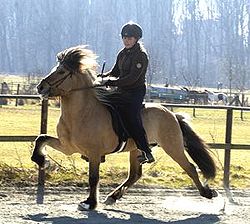
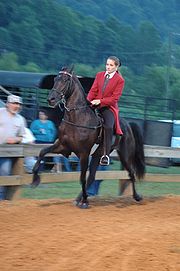
United States
The United States of America is a federal constitutional republic comprising fifty states and a federal district...
, horses that are able to do an ambling gait are referred to as "gaited." In almost all cases, the primary feature of the ambling gaits is that 3 of the 4 feet are on the ground at any time, reflected in the colloquial term, "singlefoot."
All ambling gaits are faster than a walk but usually slower than a canter. They are smoother for a rider than either a trot or a pace and most can be sustained for relatively long periods of time, making them particularly desirable for trail riding
Trail riding
Trail riding sometimes called horse or pony trekking is riding outdoors on natural trails and roads as opposed to riding in an enclosed area such as a riding arena. The term may encompass those who travel on horses, on mountain bikes, or on motorcycles and other motorized all-terrain vehicles...
and other tasks where a rider must spend long periods of time in the saddle. There are two basic types: lateral, wherein the front and hind feet on the same side move in sequence, and diagonal, where the front and hind feet on opposite sides move in sequence. Ambling gaits are further distinguished by whether the footfall rhythm is isochronous
Isochronous
Isochronous : From Greek iso, equal + chronos, time. It literally means regularly, or at equal time intervals. In general English language, it refers to something that occurs at a regular interval, of the same duration; as opposed to synchronous which refers to more than one thing happening at the...
, four equal beats in a 1-2-3-4 rhythm; or a non isochronous 1-2, 3-4 rhythm created by a slight pause between the groundstrike of the forefoot of one side to the rear of the other.
Not all horses can perform an ambling gait. However, many breeds can be trained to produce them, and there are several breeds of horses who inherit the ability to perform these gaits either naturally from birth or with a minimal amount of training.
The major ambling gaits include:
- The fox trot is most often associated with the Missouri Foxtrotter breed, but is also seen under different names in other gaited breeds. The fox trot is a four-beat diagonal gait in which the front foot of the diagonal pair lands before the hind. The same footfall pattern is characteristic of the trocha, pasitrote and marcha batida seen in various South American breeds.
- Many South American horse breeds have a range of smooth intermediate lateral ambling gaits. The Paso FinoPaso FinoThe Paso Fino is a naturally gaited light horse breed dating back to horses imported to the Caribbean from Spain. Pasos are prized for their smooth, natural, four beat, lateral ambling gait and are used in many disciplines, but are especially popular for trail riding...
's speed variations are called (from slowest to fastest) the paso fino, paso corto, and paso largo. The Peruvian PasoPeruvian PasoThe Peruvian Paso or Peruvian Horse is a breed of light pleasure saddle horse known for its smooth ride. It is distinguished by a natural, four-beat, lateral gait called the paso llano.-History:...
's lateral gaits are known as the paso llano and sobreandando. The lateral gait of the Mangalarga Marchador is called the marcha picada. - The rack or racking is a lateral gait most commonly associated with the Five-Gaited American SaddlebredAmerican SaddlebredThe American Saddlebred, formerly known as the American Saddle Horse, is a breed of horse that was developed in Kentucky by plantation owners. Today, in the horse show world, they are most commonly seen under saddle in Saddle seat style riding, and in various types of driving, including pleasure...
. In the rack, the speed is increased to be approximately that of the pace, but it is a four-beat gait with equal intervals between each beat. - The Running Walk, a four-beat lateral gait with footfalls in the same sequence as the regular walk, but characterized by greater speed and smoothness. It is a distinctive natural gait of the Tennessee Walking Horse.
- The slow gait is a general term for various lateral gaits that follow the same general lateral footfall pattern, but the rhythm and collection of the movements are different. Terms for various slow gaits include the stepping pace and singlefoot.
- The Tölt is a gait that is often described as being unique to the Icelandic HorseIcelandic horseThe Icelandic horse is a breed of horse developed in Iceland. Although the horses are small, at times pony-sized, most registries for the Icelandic refer to it as a horse. Icelandic horses are long-lived and hardy. In their native country they have few diseases; Icelandic law prevents horses from...
. The footfall pattern is the same as for the rack, but the tölt is characterized by more freedom and liquidity of movement. Some breeds of horses that are related to the Icelandic horse, living in the Faroe IslandsFaroe IslandsThe Faroe Islands are an island group situated between the Norwegian Sea and the North Atlantic Ocean, approximately halfway between Scotland and Iceland. The Faroe Islands are a self-governing territory within the Kingdom of Denmark, along with Denmark proper and Greenland...
and NorwayNorwayNorway , officially the Kingdom of Norway, is a Nordic unitary constitutional monarchy whose territory comprises the western portion of the Scandinavian Peninsula, Jan Mayen, and the Arctic archipelago of Svalbard and Bouvet Island. Norway has a total area of and a population of about 4.9 million...
, also tölt. - The revaal or ravaal is a four-beat lateral gait associated with MarwariMarwari horseThe Marwari or Malani is a rare breed of horse from the Marwar region of India. Known for its inward-turning ear tips, it comes in all equine colours, although pinto patterns tend to be the most popular with buyers and breeders. It is known for its hardiness, and is quite similar to the...
, KathiawariKathiawariThe Kathiawari is a breed of horse from India, originating in the Kathiawar peninsula. Closely related to the Marwari horse, and resembling both that breed and the Arabian horse from which they descend, the Kathiawari was originally bred as a desert war horse for use over long distances, in rough...
or Sindhi horse breeds of India.
External links
- Photographs of various horse traits, by Eadweard MuybridgeEadweard MuybridgeEadweard J. Muybridge was an English photographer who spent much of his life in the United States. He is known for his pioneering work on animal locomotion which used multiple cameras to capture motion, and his zoopraxiscope, a device for projecting motion pictures that pre-dated the flexible...
, Animals in Motion - Gaits of the Horse
- Animations of the gaits of the Icelandic horse
- Map detailing the relationship between the gaits of the Icelandic horse
- Equix: Bluegrass Thoroughbred Services, Greenfield Farm - videos of walking gaits of various racehorses
- Natural Gaits of the Horse from eXtension

